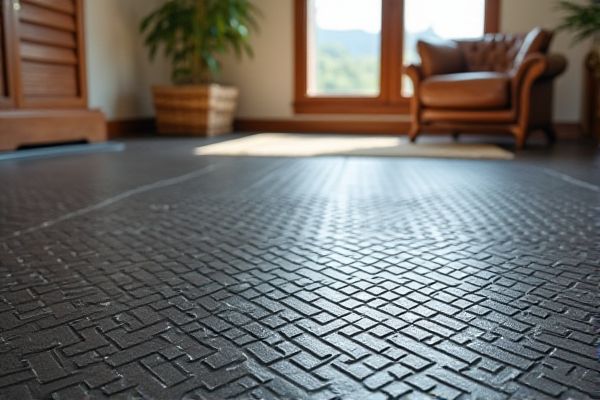
Rubber mat flooring offers superior shock absorption and noise reduction, making it ideal for gym or play areas, while interlocking tiles provide easy installation and customizable designs suitable for garages and workshops. Explore the rest of the article to determine which flooring option best fits your specific needs and lifestyle.
Table of Comparison
| Feature | Rubber Mat Flooring | Interlocking Tiles |
|---|---|---|
| Material | Natural or synthetic rubber | Rubber, PVC, or foam composites |
| Installation | Roll-out or puzzle-style mats | Snap-together interlocking system |
| Durability | High resistance to wear and tear | Moderate to high, varies by material |
| Shock Absorption | Excellent cushioning for impact | Good to excellent, depending on thickness |
| Maintenance | Easy to clean, water resistant | Easy to replace individual tiles, requires regular cleaning |
| Cost | Moderate to high | Generally lower cost, varies by type |
| Applications | Gyms, playgrounds, industrial floors | Home gyms, play areas, basements |
| Aesthetic Options | Limited colors and textures | Wide variety of colors and patterns |
| Portability | Less portable due to size and weight | Highly portable and easy to move |
| Environmental Impact | Can be eco-friendly if recyclable rubber | Varies, some eco-friendly options available |
Introduction to Rubber Mat Flooring vs Interlocking Tiles
Rubber mat flooring offers durability, slip resistance, and cushioning, making it ideal for gyms and play areas. Interlocking tiles provide modular installation, easy replacement, and design flexibility suited for both commercial and residential spaces. Both flooring options enhance safety and comfort but differ in installation and maintenance requirements.
Material Composition and Durability
Rubber mat flooring is composed primarily of natural or synthetic rubber, offering high elasticity and resistance to wear, making it ideal for heavy-duty applications with excellent shock absorption. Interlocking tiles are typically made from PVC or vinyl, providing a rigid surface that is durable but less flexible than rubber, with strong resistance to chemicals and stains. Both materials are designed for durability, but rubber mats excel in impact resistance and longevity in high-traffic or gym environments, while interlocking tiles offer ease of installation and maintenance in commercial or residential settings.
Installation Process Comparison
Rubber mat flooring offers a straightforward installation process with its flexible sheets that can be cut and laid directly on the subfloor, requiring minimal surface preparation. Interlocking tiles feature a modular design that snaps together securely, providing ease of customization and quick assembly without adhesives, ideal for creating seamless flooring patterns. Your choice depends on whether you prefer the continuous, cushioned surface of rubber mats or the versatile, easily replaceable sections of interlocking tiles.
Comfort and Safety Features
Rubber mat flooring offers superior cushioning and shock absorption, reducing fatigue and minimizing injury risks in high-impact areas. Interlocking tiles provide stability and slip resistance, enhancing safety during movement while being easy to replace if damaged. Both options contribute to ergonomic comfort, but rubber mats typically deliver greater noise reduction and thermal insulation.
Maintenance and Cleaning Requirements
Rubber mat flooring requires minimal maintenance with occasional sweeping and mopping to prevent dirt buildup, making it ideal for high-traffic areas. Interlocking tiles demand regular cleaning of seams where dust and debris can accumulate, and periodic disassembly might be necessary to address deep cleaning or damage. Your choice should consider the ease of upkeep, as rubber mats generally offer a more straightforward cleaning process compared to the detailed care needed for interlocking tiles.
Aesthetic Options and Customization
Rubber mat flooring offers limited aesthetic options, typically found in solid colors and basic textures, making customization minimal. Interlocking tiles provide a wider variety of patterns, colors, and finishes, allowing your space to reflect personal style and design preferences. Choosing interlocking tiles enhances aesthetic versatility while maintaining functional benefits.
Cost Analysis and Value for Money
Rubber mat flooring generally offers a lower initial cost compared to interlocking tiles, making it a budget-friendly option for large areas. Interlocking tiles provide greater durability and easier replacement of damaged sections, enhancing long-term value for money. Your choice depends on balancing upfront expenses with long-term maintenance and durability needs.
Ideal Applications and Use Cases
Rubber mat flooring is ideal for gyms, play areas, and industrial settings due to its shock absorption, slip resistance, and durability under heavy impact. Interlocking tiles suit commercial and residential spaces requiring quick installation, customization, and ease of replacement, such as garages, workshops, and basements. Both options provide versatility, but rubber mats excel in high-impact zones, while interlocking tiles are preferred for modular and aesthetic flooring solutions.
Environmental Impact and Sustainability
Rubber mat flooring, often made from recycled tires, offers a sustainable option by repurposing waste materials and reducing landfill impact, while some interlocking tiles are produced from virgin plastics, which may contribute to higher environmental costs. Interlocking tiles can be made from eco-friendly materials such as recycled PVC or natural fibers, but their manufacturing processes typically involve greater energy consumption and carbon emissions than rubber mats. Both flooring types vary significantly in recyclability and biodegradability, with rubber mats generally exhibiting superior lifecycle sustainability due to their renewable content and longer durability.
Conclusion: Choosing the Best Flooring Option
Rubber mat flooring offers superior shock absorption and durability, making it ideal for high-impact areas, while interlocking tiles provide easy installation and customizable designs for versatile space usage. Your decision depends on factors like budget, maintenance preferences, and the specific functionality required for the area. Opt for rubber mats if longevity and comfort are priorities, or choose interlocking tiles for flexible, quick flooring solutions.
 homyna.com
homyna.com